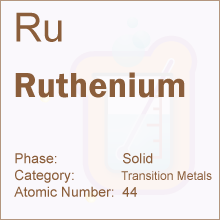 Periodic Table -> Ruthenium
Periodic Table -> RutheniumRuthenium
Ruthenium DetailsRuthenium Symbol: Ru
Ruthenium Atomic Number: 44
Ruthenium Atomic Weight: 101.07
What is Ruthenium?
Ruthenium (number 44, symbol Ru) is a transition metal that belongs to the platinum group metals together with iridium, osmium, and rhodium. It was discovered and isolated by the Polish chemist and physician Andrew Sniadecki in 1807.
Properties and Occurrence
Ruthenium is a rare metal that is mainly found in deposits of other platinum group metals. There are deposits in South Africa, Canada, and the Ural Mountains. Iridium, rhodium, ruthenium, and osmium are separated from base metals and gold. It is also extracted from the iron-nickel sulfide pentlandite. The metal is also found in ruthenarsenite, ruarsite, laurite, and other minerals, but they are rare.
This element has a hexagonal close-packed structure and is white in color. It is a hard metal with many oxidation states, but +4, +3, and +2 are the most common ones. The metal also forms compounds such as ruthenides and oxides. The most stable radioisotope is ruthenium-106, and there are 34 radioisotopes in total. Most have a very short half life of less than 5 minutes. The element itself is made up of several isotopes, including Ru-104, Ru-102, Ru-101, and Ru-100. Ru-102 is the most common one. The metal does not react with acids, water, and air.
Applications
The element is added to palladium and platinum to produce electrical contacts. Manufacturers also use compounds such as bismuth and lead ruthenates and ruthenium dioxide to make chip resistors. Some complexes and isotopes have industrial applications and are used for medical purposes. Ru-106, for example, is used in the treatment of eye tumors. Iodine-125 is also used. Ru-106 is more commonly used, however, because it causes less damage to the eye. It can be combined with iodine-125, cobalt-60, or other isotopes for therapeutic purposes. Or it can be used in combination with therapies such as transpupillary thermotherapy and local resection. Ru-106 is usually combined with gamma-emitting isotopes for eye cancer treatment. The metal is also added to alloys with tungsten, nickel, molybdenum, and cobalt. Its compounds have applications in the glass and ceramics industries. In addition to alloys, the metal is used in the chemical and electronics industries, for example, in anodes.

Ruthenium is also a catalyst in pharmaceutical and organic chemistry. The production of ethanol acid and ammonia involves ruthenium as well. The metal has potential to be used in sun-powered technologies and systems. Some of its compounds absorb light and can be used in place of conventional technologies. One compound, ruthenium(VIII) oxide has applications in the electronics industry and is used to make potentiometers, resistors, and other parts and components.
Human Health and the Environment
Its compounds have carcinogenic properties and are found to be toxic. One of its compounds, ruthenium oxide is a health hazard because it is volatile and very toxic. Ruthenium can enter the body through ingestion, and it is suggested that the metal is deposited in the bones. Ruthenium tetroxide should be avoided because it is unstable and poisonous. It is handled in hood because the fumes are toxic and can irritate the lungs, throat, mouth, eyes, and skin. The compound explodes at temperatures above 106 °C (222.8 °F) and reacts with sulfur, cellulose, ethanol, charcoal, and hydriodic acid. Violent and explosive reactions occur with compounds such as phosphorus tribromide and ammonia. While handling, it is important to wear face and eye protection as well as gloves and protective clothing. Radionuclides such as Ru-106 are also harmful for human health because they increase the risk for cancer. With a half life of 373 days, Ru-106 has been used to test nuclear weapons. It was isolated in 1844 by K.K. Klaus.
You can
link to this page, using the code below:
Periodic Table |
Banks
© ElementsDatabase.com 2015 | Privacy | About | Contact